Статьи журнала - International Journal of Intelligent Systems and Applications
Все статьи: 1126
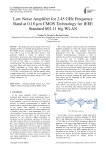
Статья научная
This paper presents the design of low noise amplifier (LNA) at 2.45 GHz and integrated at 0.18 µm RF CMOS process technology. This type of LNA at 2.45 GHz is use in the Bluetooth receiver. The proposed method is useful to optimize noise performance and power gain while maintaining good input and output matching. The amplifier is designed to be used as first stage of a receiver for wireless communication. The main aim of designer is to achieve low noise figure with improved gain with the help of CMOS technology by using single stage n-MOS amplifier. The simulation results show a forward gain of 14.0 dB, a noise-figure of 0.5 dB and stability factor is approximate unity, in which the circuit operates at 14.2 mA drain current with supply voltage of 3.5 V and biasing voltage of 1.5 V.
Бесплатно
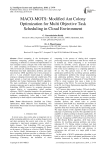
MACO-MOTS: modified ant colony optimization for multi objective task scheduling in cloud environment
Статья научная
Cloud computing is the development of distributed computing, parallel computing, and grid computing, or defined as a commercial implementation of such computer science concepts. One of the main issues in a cloud computing environment is Task scheduling (TS). In Cloud task scheduling, many Non deterministic Polynomial time-hard optimization problem, and many meta-heuristic (MH) algorithms have been proposed to solve it. A task scheduler should adapt its scheduling strategy to changing environment and variable tasks. This paper amends a cloud task scheduling policy based on Modified Ant Colony Optimization (MACO) algorithm. The main contribution of recommended method is to minimize makespan and to perform Multi Objective Task Scheduling (MOTS) process by assigning pheromone amount relative to corresponding virtual machine efficiency. MACO algorithm improves the performance of task scheduling by reducing makespan and degree of imbalance comparatively lower than a basic ACO algorithm by its multi-objective and deliberate nature.
Бесплатно
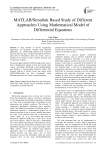
Статья научная
A large number of diverse engineering applications are frequently modeled using different approaches, viz., a differential equation or by a transfer function and state space. All these descriptions provide a great deal of information about the system, such as stability of the system, its step or impulse response, and its frequency response. The present paper addresses different approaches used to derive mathematical models of first and second order system, developing MATLAB script implementation and building a corresponding Simulink model. The dynamic analysis of electric circuit and system using MATLAB/Simulink has been investigated using different approaches for chosen system parameters..
Бесплатно
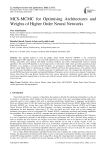
MCS-MCMC for Optimising Architectures and Weights of Higher Order Neural Networks
Статья научная
The standard method to train the Higher Order Neural Networks (HONN) is the well-known Backpropagation (BP) algorithm. Yet, the current BP algorithm has several limitations including easily stuck into local minima, particularly when dealing with highly non-linear problems and utilise computationally intensive training algorithms. The current BP algorithm is also relying heavily on the initial weight values and other parameters picked. Therefore, in an attempt to overcome the BP drawbacks, we investigate a method called Modified Cuckoo Search-Markov chain Monté Carlo for optimising the weights in HONN and boost the learning process. This method, which lies in the Swarm Intelligence area, is notably successful in optimisation task. We compared the performance with several HONN-based network models and standard Multilayer Perceptron on four (4) time series datasets: Temperature, Ozone, Gold Close Price and Bitcoin Closing Price from various repositories. Simulation results indicate that this swarm-based algorithm outperformed or at least at par with the network models with current BP algorithm in terms of lower error rate.
Бесплатно
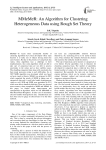
MMeMeR: An Algorithm for Clustering Heterogeneous Data using Rough Set Theory
Статья научная
In recent times enumerable number of clustering algorithms have been developed whose main function is to make sets of objects having almost the same features. But due to the presence of categorical data values, these algorithms face a challenge in their implementation. Also some algorithms which are able to take care of categorical data are not able to process uncertainty in the values and so have stability issues. Thus handling categorical data along with uncertainty has been made necessary owing to such difficulties. So, in 2007 MMR algorithm was developed which was based on basic rough set theory. MMeR was proposed in 2009 which surpassed the results of MMR in taking care of categorical data and it could also handle heterogeneous values as well. SDR and SSDR were postulated in 2011 which were able to handle hybrid data. These two showed more accuracy when compared to MMR and MMeR. In this paper, we further make improvements and conceptualize an algorithm, which we call MMeMeR or Min-Mean-Mean-Roughness. It takes care of uncertainty and also handles heterogeneous data. Standard data sets have been used to gauge its effectiveness over the other methods.
Бесплатно

Статья научная
Cloud computing is considered a pattern for distributed and heterogeneous computing derived from many resources, and requests aim to share resources. Recently, cloud computing is graded among the top best technologies globally, which must be scheduled favorably to maximize providers’ profit and improve service quality for their customers. Scheduling specifies how users’ requests are assigned to virtual machines, and it plays a vital role in the efficiency and capability of the system. Its objective is to have a throughput or complete jobs in minimum time and the highest standard. Scheduling jobs in heterogeneous distributed systems is an NP-hard polynomial indecisive problem that is not solvable in polynomial time for real-time scheduling. The time complexity of jobs is growing exponentially, and this problem has a considerable effect on the quality of cloud services and providers’ efficiencies. The optimization of scheduling-related parameters using heuristic and meta-heuristic algorithms can reduce the search space complexity and execution time. This study intends to represent a fitness function to minimize time and cost parameters. The proposed method uses a multi-purposed weighted genetic algorithm that provides six basic parameters: utility, task execution cost, response time, wait time, Makespan, and throughput to provide comprehensive optimization. The proposed approach improved response and wait times, throughput, Makespan, and utility 16, 9, 7, 8 percentages, respectively, by only a one cost unit reduction, which is dispensable. As a result, both providers and users will experience better services. The statistical tests show that the achieved improvement is valid for 94% of experiments.
Бесплатно
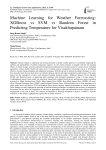
Статья научная
Climate change, a significant and lasting alteration in global weather patterns, is profoundly impacting the stability and predictability of global temperature regimes. As the world continues to grapple with the far-reaching effects of climate change, accurate and timely temperature predictions have become pivotal to various sectors, including agriculture, energy, public health and many more. Crucially, precise temperature forecasting assists in developing effective climate change mitigation and adaptation strategies. With the advent of machine learning techniques, we now have powerful tools that can learn from vast climatic datasets and provide improved predictive performance. This study delves into the comparison of three such advanced machine learning models—XGBoost, Support Vector Machine (SVM), and Random Forest—in predicting daily maximum and minimum temperatures using a 45-year dataset of Visakhapatnam airport. Each model was rigorously trained and evaluated based on key performance metrics including training loss, Mean Absolute Error (MAE), Mean Squared Error (MSE), Root Mean Squared Error (RMSE), R2 score, Mean Absolute Percentage Error (MAPE), and Explained Variance Score. Although there was no clear dominance of a single model across all metrics, SVM and Random Forest showed slightly superior performance on several measures. These findings not only highlight the potential of machine learning techniques in enhancing the accuracy of temperature forecasting but also stress the importance of selecting an appropriate model and performance metrics aligned with the requirements of the task at hand. This research accomplishes a thorough comparative analysis, conducts a rigorous evaluation of the models, highlights the significance of model selection.
Бесплатно
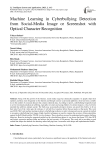
Статья научная
Along with the growth of the Internet, social media usage has drastically expanded. As people share their opinions and ideas more frequently on the Internet and through various social media platforms, there has been a notable rise in the number of consumer phrases that contain sentiment data. According to reports, cyberbullying frequently leads to severe emotional and physical suffering, especially in women and young children. In certain instances, it has even been reported that sufferers attempt suicide. The bully may occasionally attempt to destroy any proof they believe to be on their side. Even if the victim gets the evidence, it will still be a long time before they get justice at that point. This work used OCR, NLP, and machine learning to detect cyberbullying in photos in order to design and execute a practical method to recognize cyberbullying from images. Eight classifier techniques are used to compare the accuracy of these algorithms against the BoW Model and the TF-IDF, two key features. These classifiers are used to understand and recognize bullying behaviors. Based on testing the suggested method on the cyberbullying dataset, it was shown that linear SVC after OCR and logistic regression perform better and achieve the best accuracy of 96 percent. This study aid in providing a good outline that shapes the methods for detecting online bullying from a screenshot with design and implementation details.
Бесплатно
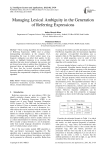
Managing Lexical Ambiguity in the Generation of Referring Expressions
Статья научная
Most existing algorithms for the Generation of Referring Expressions (GRE) tend to produce distinguishing descriptions at the semantic level, disregarding the ways in which surface issues (e.g. linguistic ambiguity) can affect their quality. In this article, we highlight limitations in an existing GRE algorithm that takes lexical ambiguity into account, and put forward some ideas to address those limitations. The proposed ideas are implemented in a GRE algorithm. We show that the revised algorithm successfully generates optimal referring expressions without greatly increasing the computational complexity of the (original) algorithm.
Бесплатно
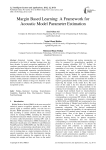
Margin Based Learning: A Framework for Acoustic Model Parameter Estimation
Статья научная
Statistical learning theory has been introduced in the field of machine learning since last three decades. In speech recognition application, SLT combines generalization function and empirical risk in single margin based objective function for optimization. This paper incorporated separation (misclassification) measures conforming to conventional discriminative training criterion in loss function definition of margin based method to derive the mathematical framework for acoustic model parameter estimation and discuss some important issues related to hinge loss function of the derived model to enhance the performance of speech recognition system.
Бесплатно
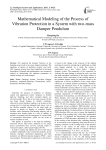
Статья научная
We analyzed the dynamic behavior of the damping system with a two-mass damper pendulum. The equations of motion of nonlinear systems were built. AFC equation systems have been identified in the linear formulation. Proposed and implemented a new numerical method of determining the optimum parameters of optimal settings two-mass damper.
Бесплатно
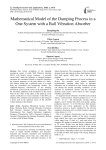
Mathematical model of the damping process in a one system with a ball vibration absorber
Статья научная
The forced oscillations of the damping mechanical system of solids "Ball Vibration Absorber (BVA) with linearly viscous resistance – a movable carrier body" under the influence of external harmonic excitation are considered. Based on Appell's formalism, the dynamic equations for the joint motion of a heavy ball without sliding into a spherical cavity of a carrier body are formulated and numerically studied. The amplitude-frequency characteristic of the damping mechanical system and the curves of the dependences of the maximum amplitude of the oscillations of the carrier body on the values of the radius of the spherical cavity and the coefficient of viscous resistance of the BVA are obtained. The conditions and restrictions on the rolling of a heavy ball in the spherical recess of the absorber without sliding are determined.
Бесплатно
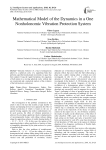
Mathematical model of the dynamics in a one nonholonomic vibration protection system
Статья научная
Dynamic behavior of a heavy homogeneous sphere in a spherical cavity of a supporting body that performs specified translational movements in space has been studied. Using the Appel formalism, the equations of ball motion in a moving spherical cavity without slip are constructed and a numerical analysis of the evolution of the ball motion is carried out.
Бесплатно
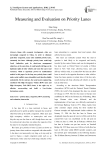
Measuring and Evaluation on Priority Lanes
Статья научная
Along with economic development, cities are increasingly congested in China. In order to eliminate peak-hour congestion, many cities establish priority lanes, commonly bus lanes. Although priority lanes could help Local Authorities gain its short-term management objectives, at the same time, it would greatly infringe on the legitimate rights of other vehicles and waste the scarce road resources, which is rigorously proved by mathematical models in this paper. In the long run, priority lanes would make social conflicts more intensified, and therefore highly undesirable. On the contrary, the social system engineering, combined with High Occupancy Vehicle (HOV) lanes and High Occupancy Toll (HOT) lanes, is the right way to alleviate overcrowding and build a Low-Carbon harmonious society.
Бесплатно
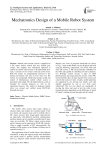
Mechatronics Design of a Mobile Robot System
Статья научная
Mobile robot motion control is simplified to a DC motor motion control that may include gear system. The simplest and widespread approach to control the mobile robot motion is the differential drive style, it consists of two in-lines with each a DC motor. Both DC motors are independently powered so the desired movements will rely on how these two DC motors are commanded. Thedevelop design, model and control of Mechatronics mobile robotic system is presented in this paper. The developed robotic system is intended for research purposes as well as for educational process. The model of proposed mobile robot was created and verified using MATLAB-Simulink software.
Бесплатно
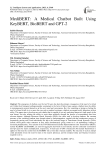
MediBERT: A Medical Chatbot Built Using KeyBERT, BioBERT and GPT-2
Статья научная
The emergence of chatbots over the last 50 years has been the primary consequence of the need of a virtual aid. Unlike their biological anthropomorphic counterpart in the form of fellow homo sapiens, chatbots have the ability to instantaneously present themselves at the user's need and convenience. Be it for something as benign as feeling the need of a friend to talk to, to a more dire case such as medical assistance, chatbots are unequivocally ubiquitous in their utility. This paper aims to develop one such chatbot that is capable of not only analyzing human text (and speech in the near future), but also refining the ability to assist them medically through the process of accumulating data from relevant datasets. Although Recurrent Neural Networks (RNNs) are often used to develop chatbots, the constant presence of the vanishing gradient issue brought about by backpropagation, coupled with the cumbersome process of sequentially parsing each word individually has led to the increased usage of Transformer Neural Networks (TNNs) instead, which parses entire sentences at once while simultaneously giving context to it via embeddings, leading to increased parallelization. Two variants of the TNN Bidirectional Encoder Representations from Transformers (BERT), namely KeyBERT and BioBERT, are used for tagging the keywords in each sentence and for contextual vectorization into Q/A pairs for matrix multiplication, respectively. A final layer of GPT-2 (Generative Pre-trained Transformer) is applied to fine-tune the results from the BioBERT into a form that is human readable. The outcome of such an attempt could potentially lessen the need for trips to the nearest physician, and the temporal delay and financial resources required to do so.
Бесплатно
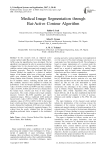
Medical Image Segmentation through Bat-Active Contour Algorithm
Статья научная
In this research work, an improved active contour method called Bat-Active Contour Method (BA-ACM) using bat algorithm has been developed. The bat algorithm is incorporated in order to escape local minima entrapped into by the classical active contour method, stabilize contour (snake) movement and accurately, reach boundary concavity. Then, the developed Bat-Active Contour Method was applied to a dataset of medical images of the human heart, bone of knee and vertebra which were obtained from Auckland MRI Research Group (Cardiac Atlas Website), University of Auckland. Set of similarity metrics, including Jaccard index and Dice similarity measures were adopted to evaluate the performance of the developed algorithm. Jaccard index values of 0.9310, 0.9234 and 0.8947 and Dice similarity values of 0.8341, 0.8616 and 0.9138 were obtained from the human heart, vertebra and bone of knee images respectively. The results obtained show high similarity measures between BA-ACM algorithm and expert segmented images. Moreso, traditional ACM produced Jaccard index values 0.5873, 0.5601, 0.6009 and Dice similarity values of 0.5974, 0.6079, 0.6102 in the human heart, vertebra and bone of knee images respectively. The results obtained for traditional ACM show low similarity measures between it and expertly segmented images. It is evident from the results obtained that the developed algorithm performed better compared to the traditional ACM.
Бесплатно
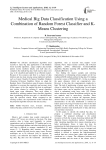
Статья научная
An efficient classification algorithm used recently in many big data applications is the Random forest classifier algorithm. Large complex data include patient record, medicine details, and staff data etc., comprises the medical big data. Such massive data is not easy to be classified and handled in an efficient manner. Because of less accuracy and there is a chance of data deletion and also data missing using traditional methods such as Linear Classifier K-Nearest Neighbor, Random Clustering K-Nearest Neighbor. Hence we adapt the Random Forest Classification using K-means clustering algorithm to overcome the complexity and accuracy issue. In this paper, at first the medical big data is partitioned into various clusters by utilizing k- means algorithm based upon some dimension. Then each cluster is classified by utilizing random forest classifier algorithm then it generating decision tree and it is classified based upon the specified criteria. When compared to the existing systems, the experimental results indicate that the proposed algorithm increases the data accuracy.
Бесплатно
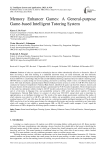
Memory Enhancer Games: A General-purpose Game-based Intelligent Tutoring System
Статья научная
Students of today are exposed to technologies that are either educationally effective or distractive. Most of them are having a hard time learning in a traditional classroom setup, are easily distracted, and have difficulty remembering lessons just learned and prerequisite skills needed in learning new lessons. Game-Based Intelligent Tutoring System (GB-ITS) is a technology that provides an individualized learning experience based on student’s learning needs. GB-ITS mimics a teacher doing one-on-one teaching, also known as tutoring, which is more cost-efficient than human tutors. This study developed a general-purpose Memory Enhancer Games system, in a form of a GB-ITS. This study was conducted at Calasiao Comprehensive National High School, identified the game type that best enhances memory and the game features for this proposed system through a questionnaire by (9) ICT teacher respondents. The developed system in this study has undergone validity testing by (8) ICT teachers and professors from Schools Division I of Pangasinan, and of a University in Dagupan City, and acceptability testing by (100) senior high school students of Calasiao Comprehensive National High School, 1st semester of school year 2022-2023, using Likert scale to determine its appropriateness as an intelligent learning tool. The results of the game design questionnaire confirmed the studies of which elements were ideal for a GB-ITS, and both the validity and acceptability survey questionnaires with overall weighted means of 4.57 and 4.08, show that the system is a valid and acceptable intelligent learning tool. The developed MEG can also be of use for testing game features for educational effectiveness and can also contribute to any future study which will conduct to test whether a general-purpose GBL or GB-ITS model would compare; if won’t equal the effectiveness of GBLs designed for delivering specific contents or subjects.
Бесплатно
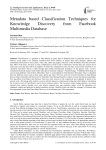
Metadata based Classification Techniques for Knowledge Discovery from Facebook Multimedia Database
Статья научная
Classification is a parlance of Data Mining to genre data of different kinds in particular classes. As we observe, social media is an immense manifesto that allows billions of people share their thoughts, updates and multimedia information as status, photo, video, link, audio and graphics. Because of this flexibility cloud has enormous data. Most of the times, this data is much complicated to retrieve and to understand. And the data may contain lot of noise and at most the data will be incomplete. To make this complication easier, the data existed on the cloud has to be classified with labels which is viable through data mining Classification techniques. In the present work, we have considered Facebook dataset which holds meta data of cosmetic company’s Facebook page. 19 different Meta Data are used as main attributes. Out of those, Meta Data ‘Type’ is concentrated for Classification. Meta data ‘Type’ is classified into four different classes such as link, status, photo and video. We have used two favored Classifiers of Data Mining that are, Bayes Classifier and Decision Tree Classifier. Data Mining Classifiers contain several classification algorithms. Few algorithms from Bayes and Decision Tree have been chosen for the experiment and explained in detail in the present work. Percentage split method is used to split the dataset as training and testing data which helps in calculating the Accuracy level of Classification and to form confusion matrix. The Accuracy results, kappa statistics, root mean squared error, relative absolute error, root relative squared error and confusion matrix of all the algorithms are compared, studied and analyzed in depth to produce the best Classifier which can label the company’s Facebook data into appropriate classes thus Knowledge Discovery is the ultimate goal of this experiment.
Бесплатно

